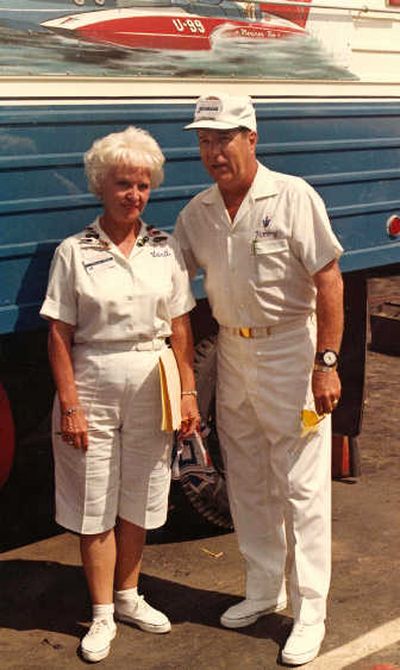Tributes: Lucile Woods enjoyed boat races

Lucile Woods was hydroplane racing’s mother figure.
Barely 5 feet tall and weighing less than 100 pounds, she loomed large in the family of big-time hydroplane racing, which she adopted, watched over and helped nurture for more than half a century.
The Spokane resident died on May 28 at age 94. “She outlived most of the ones she worked with,” said longtime friend Mike Fitzsimmons.
Born on Valentine’s Day 1913, Lucile remained feisty all her life.
She completed Bloomsday as recently as 1999, when newspaper records show she was the eighth-oldest person to do so. She rode a camel in Egypt in recent years. And Fitzsimmons recalled that he brought a wheelchair to hydroplane races, but Woods, in her 90s, refused to use it.
She was heavily involved in the March of Dimes, as an employee and member of its board of directors.
She also was a charter member of Beta Sigma Phi sorority and was recognized earlier this year on her 75th anniversary as an active member. And she established a $25,000 trust fund to help provide college scholarships.
But it was the roaring hydroplanes that were a passion for Lucile and her husband, Harry, who died on New Year’s Day 1980. Never having had children, the hydroplane community was the couple’s family.
According to an obituary published by the American Boat Racing Association, Harry and Lucile Woods began their love affair with racing in the late 1920s in the Midwest. Harry was an outboard competitor; Lucile was his crew chief.
At a time when safety equipment and standards left a lot to be desired – and many of Harry’s fellow drivers were losing arms and legs – Harry stopped driving and started officiating.
The couple moved from Lincoln, Neb., to Spokane in 1947, and Harry started a 30-year career at Camp Chevrolet in 1950, according to his obituary. He had been an Army master sergeant in the Pacific during World War II.
Once settled, they returned to competitive racing.
“They ran all over the place,” Fitzsimmons said. Harry was a pretty good driver, but he was more of an organizer.
So it wasn’t long before the Woods stopped racing. Harry would referee – he was named 1972’s official of the year by the Unlimited Racing Commission. Lucile would do scoring and timing.
“She was very good at it,” Fitzsimmons said.
That would never be more evident than in the 1955 Gold Cup, when Lucile’s eye for detail determined the race winner to be Detroit’s Gale V, driven by Lee Schoenith.
In those days, the Gold Cup site was determined by the home of the winning boat. Seattle, thanks to the line of famed Slo-Mo-Shun boats, had a stranglehold on hosting the race in the early 1950s. Back then, the race winner was based on total points earned in heats and the final race, not who won the final heat.
The Gale had won only one heat and finished second in two others. Bill Muncey, in Seattle’s Miss Thriftway, figured a third place would keep the Gold Cup in the Northwest for 1956.
But Lucile did the math and determined Schoenith had been on the course 3.54 seconds less than Muncey. The 400 bonus points the Gale earned for lowest elapsed time was the difference that sent the Gold Cup to Detroit.
Lucile and Harry Woods traveled the circuit into the 1960s and 1970s. They were more than just officials in the tower.
The Woods single-handedly saved the 1965 race in Ogden, Utah, when the event promoter left a laundry list of things undone just days before the race. The couple took command and finished what needed to be done.
Fitzsimmons, who would eventually work on hydroplane crews and broadcast races, met Lucile Woods at the Seattle races in the 1950s.
“I was a little kid who was trying to figure out what was going on, and here’s someone on the inside of the fence who actually would talk to me,” said Fitzsimmons, now a Spokane radio personality.
When Fitzsimmons moved to Spokane in 1970 to attend law school, the Woods were the only people he knew in town, and their friendship grew. But with Lucile Woods’ death, a lot of traditions will be different, according to Fitzsimmons.
“The night before the Seattle race, we would always go to Ivar’s,” the famous waterfront seafood restaurant, Fitzsimmons said. “For the last 26 years, we would order a drink and an extra glass, turn it upside down and drink a toast to Harry. Now we’re going to have to order two of them.”
Following Harry Woods’ death, Lucile talked about getting out of the sport. Instead, she helped out Fitzsimmons with his broadcasts – something she continued until age 93.
During race week, Lucile spent time getting to know the boating families. She babysat kids, many of whom now are the stars of the sport.
“She became the den mother of unlimited hydroplane racing,” Fitzsimmons said.
She would work all day at the course, go shopping with the women and carry all the packages, Fitzsimmons said. “And when everyone (else) flopped on the bed, she was on the way down the hall getting ice for drinks.”
Besides being central figures on race day, Lucile and Harry Woods worked behind the scenes. They helped launch the Miss Spokane hydroplane in 1958, as well as races in Chelan, Coeur d’Alene and the Tri-Cities.
“They were prime movers, along with a group of citizens in the Tri-Cities, to put the Atomic Cup together,” Fitzsimmons said.
Without the Woods, the hydroplanes likely would not have visited the Columbia River.
The Saturday before she died, Fitzsimmons said, Lucile Woods told him, “Mike, it’s time I go and see Harry.”
“I knew,” Fitzsimmons said, “she would be gone soon.”